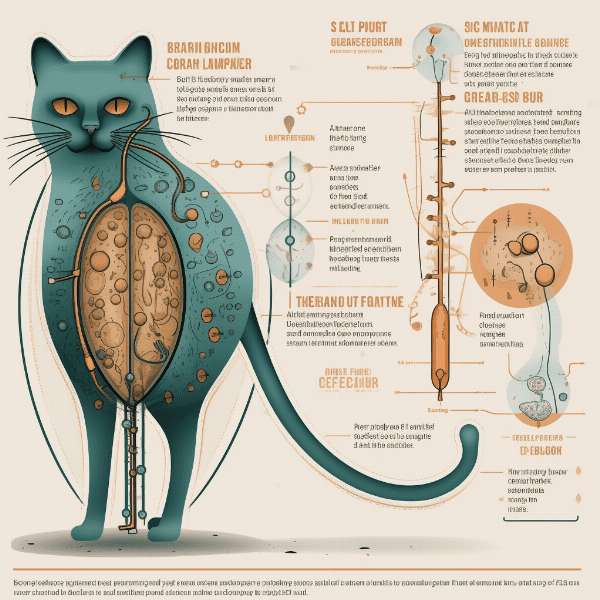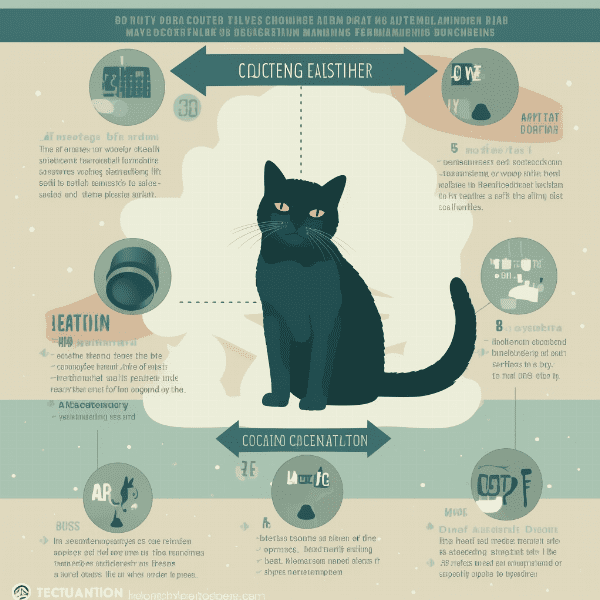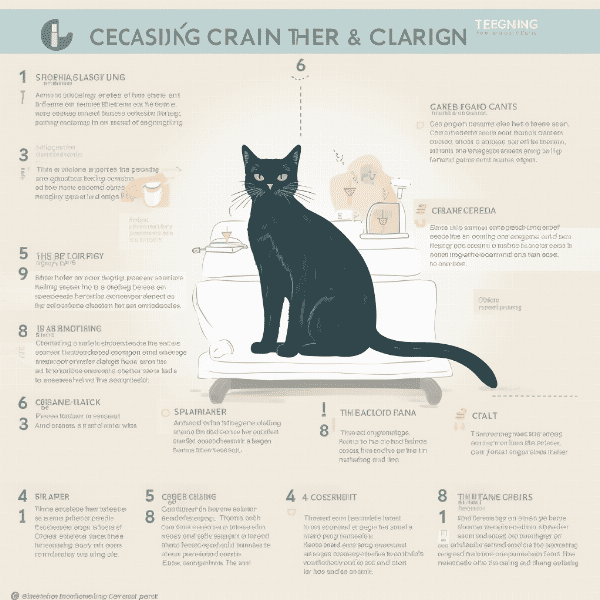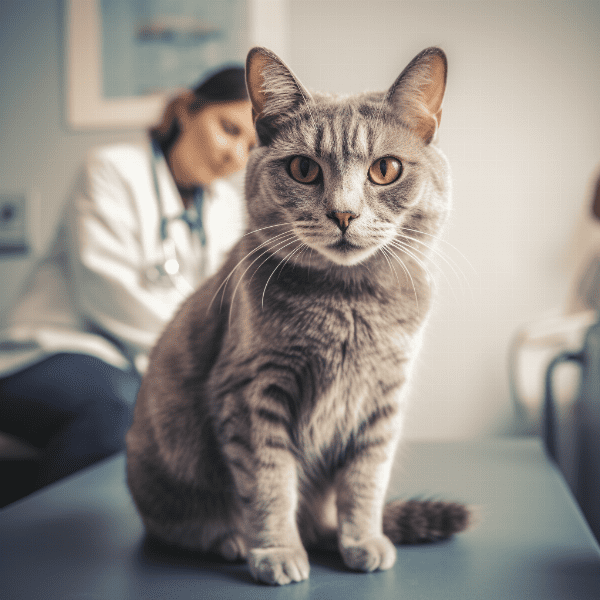Table of Contents
- Understanding Feline Bladder Cancer
- Causes and Risk Factors
- Recognizing Symptoms of Feline Bladder Cancer
- Diagnosing Feline Bladder Cancer
- Staging Feline Bladder Cancer
- Treatment Options for Feline Bladder Cancer
- Managing Side Effects of Treatment
- Prognosis and Follow-Up Care
- Preventing Feline Bladder Cancer
- Support and Resources for Feline Bladder Cancer Care
Understanding Feline Bladder Cancer
Feline bladder cancer is a type of cancer that affects the cells of the urinary bladder in cats. The bladder is an essential organ that stores urine before it is expelled from the body. Cancer can develop when the cells of the bladder start to divide and grow uncontrollably, forming a tumor.
The Role of the Bladder in Feline Urinary System
The urinary system in cats plays a crucial role in removing waste and toxins from the body. The bladder is a muscular sac that stores urine until the cat is ready to urinate. When the bladder is full, the cat can sense the need to urinate and will typically do so in a litter box or outside.
Types of Feline Bladder Cancer
There are several types of bladder cancer that can affect cats, including transitional cell carcinoma (TCC), adenocarcinoma, and squamous cell carcinoma. TCC is the most common type of Bladder cancer in cats, accounting for approximately 50-70% of all cases. Adenocarcinoma and squamous cell carcinoma are less common but can also occur.
Causes of Feline Bladder Cancer
The exact cause of feline bladder cancer is unknown, but there are several risk factors that have been identified. Exposure to environmental toxins, such as cigarette smoke, certain chemicals, and pesticides, has been linked to an increased risk of bladder cancer in cats. Age and breed may also play a role, as older cats and certain breeds, such as Siamese and Himalayan, are more susceptible to developing bladder cancer.
Spread of Feline Bladder Cancer
Feline bladder cancer can spread to other parts of the body, such as the lymph nodes, lungs, and bones, if left untreated. This can make the cancer more difficult to treat and can significantly reduce a cat’s quality of life. It is essential to diagnose and treat bladder cancer in cats as early as possible to prevent the spread of the disease.
Understanding the basics of feline bladder cancer is the first step in providing the best possible care for your furry friend. By knowing the causes, types, and spread of bladder cancer, you can take steps to prevent the disease or catch it early, ensuring the best possible outcome for your cat.

Causes and Risk Factors
The exact cause of feline bladder cancer is unknown, but several risk factors have been identified that may increase a cat’s chances of developing the disease.
Environmental Toxins
Exposure to environmental toxins is a known risk factor for feline bladder cancer. Cats who live in households with smokers are more likely to develop bladder cancer than cats who do not. This is because cigarette smoke contains harmful chemicals that can damage the cells of the bladder and increase the risk of cancer. Exposure to certain chemicals and pesticides, such as herbicides and insecticides, has also been linked to an increased risk of feline bladder cancer.
Age and Breed
Feline bladder cancer can affect cats of any age, but it is more common in older cats. Cats over the age of 10 are more likely to develop bladder cancer than younger cats. Certain breeds of cats, such as Siamese and Himalayan, are also more susceptible to developing bladder cancer than other breeds.
Gender and Neutering
Feline bladder cancer occurs more frequently in male cats than in females. Neutering male cats may reduce the risk of developing bladder cancer by decreasing exposure to certain hormones. However, the evidence for this is not conclusive, and further research is needed to understand the relationship between neutering and feline bladder cancer.
Diet
A diet that is high in carbohydrates and low in protein may increase the risk of feline bladder cancer. Cats who are fed a dry diet may also be at a higher risk than those who are fed wet food. This is because cats who eat dry food may not drink enough water, leading to concentrated urine that can damage the cells of the bladder.
Understanding the causes and risk factors of feline bladder cancer can help cat owners take steps to reduce their cat’s risk of developing the disease. By reducing exposure to environmental toxins, providing a healthy diet, and taking other preventive measures, cat owners can help ensure the long-term health of their furry friends.

Recognizing Symptoms of Feline Bladder Cancer
Recognizing the symptoms of feline bladder cancer is essential for early detection and treatment. The symptoms of bladder cancer in cats can be subtle and may be mistaken for other urinary tract conditions. However, early diagnosis and treatment can significantly improve a cat’s chances of recovery.
Changes in Urination
One of the most common symptoms of feline bladder cancer is changes in urination. Cats with bladder cancer may urinate more frequently or have difficulty urinating. They may also strain while urinating or produce only small amounts of urine. In some cases, cats with bladder cancer may urinate outside of the litter box or in inappropriate places.
Blood in Urine
Blood in the urine, also known as hematuria, is a common symptom of feline bladder cancer. The urine may appear red or pink, indicating the presence of blood. However, in some cases, the blood may not be visible to the naked eye and can only be detected through laboratory testing.
Pain or Discomfort
Cats with bladder cancer may experience pain or discomfort when urinating. They may vocalize, cry, or show signs of distress while using the litter box. In some cases, cats may avoid the litter box altogether and may appear lethargic or depressed.
Loss of Appetite and Weight Loss
Feline bladder cancer can also cause cats to lose their appetite and experience weight loss. This is because the cancer can interfere with the cat’s ability to absorb nutrients from food. Cats with bladder cancer may also appear weak or lethargic and may have a decreased interest in activities they once enjoyed.
Recognizing the symptoms of feline bladder cancer is crucial for early detection and treatment. If you notice any changes in your cat’s urination habits or other symptoms of bladder cancer, it is essential to seek veterinary care as soon as possible. Early diagnosis and treatment can significantly improve your cat’s quality of life and increase their chances of recovery.

Diagnosing Feline Bladder Cancer
Diagnosing feline bladder cancer can be challenging because the symptoms can be similar to other urinary tract conditions. However, several diagnostic tests can help identify the presence of cancer and determine its location and extent.
Physical Examination
During a physical examination, a veterinarian will assess your cat’s overall health and look for signs of feline bladder cancer, such as blood in the urine or pain during palpation of the bladder. They may also perform a rectal exam to check for abnormalities in the bladder or other parts of the urinary tract.
Urinalysis
A urinalysis can help detect the presence of blood, cancer cells, or other abnormalities in the urine. The veterinarian may also test the urine for bacteria and other infections that could be causing the symptoms.
Imaging Tests
Imaging tests, such as x-rays, ultrasound, or CT scans, can help visualize the bladder and other parts of the urinary tract. These tests can help identify the presence of tumors, the size and location of the tumors, and any signs of spread to other parts of the body.
Biopsy
A biopsy involves taking a small sample of tissue from the bladder or other affected areas for analysis. This can help determine if the growth is cancerous and what type of cancer it is. A biopsy is usually performed under anesthesia and can be done through a cystoscope or ultrasound-guided needle.
Cytology
Cytology involves examining cells from the bladder or other affected areas under a microscope. This can help identify the presence of cancer cells and determine the type of cancer. Cytology can be performed using a catheter or by aspirating cells from the bladder or other affected areas.
Diagnosing feline bladder cancer can be challenging, but with the help of various diagnostic tests, veterinarians can accurately identify the presence and extent of the disease. Early diagnosis and treatment can significantly improve your cat’s quality of life and increase their chances of recovery.

Staging Feline Bladder Cancer
Staging is the process of determining the extent of feline bladder cancer and whether it has spread to other parts of the body. Staging helps determine the best course of treatment and can provide important information about a cat’s prognosis.
Stage 0
Stage 0 bladder cancer is an early stage that involves the presence of abnormal cells in the bladder lining but has not spread to other tissues or organs. Treatment for stage 0 bladder cancer may involve monitoring or surgical removal of the affected area.
Stage III
Stage III bladder cancer involves the spread of cancerous cells to nearby lymph nodes or tissues. Treatment for stage III bladder cancer may involve surgery to remove the bladder and nearby lymph nodes, followed by chemotherapy or radiation therapy.
Stage IV
Stage IV bladder cancer involves the spread of cancerous cells to distant organs, such as the lungs, liver, or bones. Treatment for stage IV bladder cancer may involve palliative care to manage symptoms and improve quality of life.
Staging feline bladder cancer is an important step in determining the best course of treatment for your cat. Depending on the stage of the cancer, treatment options may include surgery, chemotherapy, radiation therapy, or palliative care. Your veterinarian can help you understand the staging process and provide you with information about the best treatment options for your cat.

Treatment Options for Feline Bladder Cancer
Treatment for feline bladder cancer depends on the stage and extent of the cancer, as well as the overall health of the cat. There are several treatment options available, including surgery, chemotherapy, radiation therapy, and palliative care.
Surgery
Surgery is a common treatment option for feline bladder cancer. Depending on the location and extent of the cancer, the surgery may involve removing the affected area of the bladder or the entire bladder. If the entire bladder is removed, the cat will require lifelong management of urine elimination, such as a urinary catheter or an opening in the abdomen that connects to a bag.
Chemotherapy
Chemotherapy involves the use of drugs to kill cancer cells. Chemotherapy can be used to treat feline bladder cancer that has spread to other parts of the body or as a preventative measure after surgery. The side effects of chemotherapy in cats are generally mild compared to those in humans and dogs.
.

Managing Side Effects of Treatment
Treatment for feline bladder cancer, such as surgery, chemotherapy, and radiation therapy, can cause side effects that may affect your cat’s quality of life. Understanding and managing these side effects is an essential part of providing the best possible care for your furry friend.
Surgery
After surgery to remove the bladder or part of the bladder, cats may experience difficulty urinating or require assistance with urine elimination. Your veterinarian may recommend a urinary catheter or other measures to help manage urine elimination. In addition, cats may experience pain, swelling, or infection at the site of the incision. Your veterinarian can provide pain medication and antibiotics as needed to manage these side effects.
Chemotherapy
Chemotherapy can cause side effects, such as vomiting, diarrhea, and loss of appetite. These side effects are generally mild in cats and can be managed with medication or dietary changes. In addition, chemotherapy can weaken the immune system, making cats more susceptible to infection. Your veterinarian can provide guidance on how to prevent infection and manage any symptoms that may occur.
Radiation Therapy
Radiation therapy can cause skin irritation or ulceration in the area where the radiation is targeted. Your veterinarian can provide medication to manage pain and promote healing. In addition, cats may experience fatigue or loss of appetite during radiation therapy. Providing a quiet and comfortable environment, offering soft and palatable food, and encouraging rest can help manage these side effects.
Palliative Care
Palliative care focuses on managing symptoms and improving quality of life for cats with advanced feline bladder cancer. Depending on the symptoms, palliative care may involve pain management, nutritional support, or other supportive measures. Your veterinarian can provide guidance on how to manage your cat’s symptoms and maintain their comfort and well-being.
Managing side effects of treatment is an essential part of providing the best possible care for cats with feline bladder cancer. By understanding and addressing the potential side effects of treatment, you can help ensure your cat’s overall health and well-being.

Prognosis and Follow-Up Care
The prognosis for feline bladder cancer depends on several factors, such as the stage and extent of the cancer, the cat’s overall health, and the treatment options used. Early diagnosis and treatment can significantly improve a cat’s chances of recovery and long-term survival.
Prognosis
The prognosis for feline bladder cancer varies depending on the stage of the cancer. Cats with stage 0 or stage I bladder cancer have a good prognosis, with a high likelihood of recovery with appropriate treatment. However, cats with stage II or stage III bladder cancer have a less favorable prognosis, and the cancer may be more challenging to treat. Cats with stage IV bladder cancer have a poor prognosis, and treatment may focus on palliative care to manage symptoms and improve quality of life.
Follow-Up Care
Follow-up care is essential for cats with feline bladder cancer, regardless of the stage of the cancer or the treatment options used. Regular check-ups with a veterinarian can help monitor the cat’s progress, detect any potential complications or side effects of treatment, and adjust treatment plans as needed. Follow-up care may involve regular physical exams, blood tests, imaging tests, and other diagnostic tests.
In addition, cat owners can help manage their cat’s recovery by providing a healthy diet, a safe and comfortable environment, and plenty of love and attention. Monitoring the cat’s urine output and overall behavior can also help detect any potential issues early on.
In conclusion, understanding the prognosis and follow-up care for feline bladder cancer is essential for providing the best possible care for your cat. By working closely with your veterinarian and providing appropriate care and attention, you can help improve your cat’s chances of recovery and long-term survival.

Preventing Feline Bladder Cancer
While there is no guaranteed way to prevent feline bladder cancer, there are several steps cat owners can take to help reduce the risk of developing this disease.
Regular Veterinary Check-Ups
Regular veterinary check-ups can help detect any potential health issues early on, including feline bladder cancer. During check-ups, veterinarians can perform physical exams, diagnostic tests, and offer advice on preventative measures.
Diet and Nutrition
Feeding your cat a healthy diet and providing clean water can help promote overall health and reduce the risk of feline bladder cancer. Consult with your veterinarian to determine the best diet and feeding schedule for your cat’s individual needs.
Environmental Factors
Exposure to environmental toxins, such as second-hand smoke, chemicals, and pollutants, can increase the risk of feline bladder cancer. Keeping your cat away from potential sources of toxins and providing a clean and safe living environment can help reduce the risk of cancer.
Litter Box Maintenance
Proper litter box maintenance is essential for maintaining good urinary tract health and reducing the risk of feline bladder cancer. Keep litter boxes clean and provide enough litter boxes for your cat’s needs. Encourage your cat to drink plenty of water to help flush out their urinary system.
Vaccinations
Some vaccines, such as the feline leukemia virus (FeLV) vaccine, can help reduce the risk of certain types of cancer, including feline bladder cancer. Consult with your veterinarian to determine which vaccines are recommended for your cat.
By taking preventative measures, cat owners can help reduce the risk of feline bladder cancer and promote overall health and well-being. Regular veterinary check-ups, a healthy diet, a safe living environment, and proper litter box maintenance are all essential for maintaining good urinary tract health and reducing the risk of cancer.

Support and Resources for Feline Bladder Cancer Care
Caring for a cat with feline bladder cancer can be a challenging and emotional experience. Fortunately, there are several resources and support options available for cat owners and their furry friends.
Veterinary Support
Veterinarians are essential resources for providing guidance and support for cats with feline bladder cancer. Veterinarians can offer advice on treatment options, managing side effects of treatment, and providing supportive care for cats with advanced cancer. They can also help monitor the cat’s progress and adjust treatment plans as needed.
Online Communities and Support Groups
Online communities and support groups can provide a valuable source of emotional support and information for cat owners caring for cats with feline bladder cancer. These communities and groups allow cat owners to connect with others who are experiencing similar challenges and share their experiences and advice.
Palliative Care and Hospice
For cats with advanced feline bladder cancer, palliative care and hospice care can provide essential support for managing symptoms and improving quality of life. Palliative care and hospice care can involve pain management, nutritional support, and other supportive measures. Consult with your veterinarian to determine the best palliative or hospice care options for your cat.
Pet Insurance
Pet insurance can provide financial support for the cost of treating feline bladder cancer, which can be a significant financial burden for cat owners. Pet insurance policies can cover various treatment options, such as surgery, chemotherapy, radiation therapy, and palliative care.
Caring for a cat with feline bladder cancer can be challenging, but with the help of veterinary support, online communities, palliative care and hospice care, and pet insurance, cat owners can provide the best possible care for their furry friends. By connecting with these resources and support options, cat owners can also find emotional support and encouragement to help them through this difficult time.




